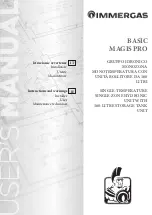
Installation and Operation Instructions Matrix
42
Table 12-2 Low Voltage Field Connections
Connection
Description
Plenum
Sensor
Plenum Temperature Sensor
– Each Matrix is provided with a temperature sensor that is to be field
installed in the supply plenum. When installed the Matrix Fan (blue) controller will display the plenum
temperature and may provide additional features depending on the application.
Outdoor
Sensor
Outdoor Temperature Sensor
– Each Matrix is provided with an outdoor temperature sensor that may be
field installed to provide Outdoor Reset for applications were the Matrix is providing heat to a Hydronic
Heating System.
H
Hydronic Heat Input
– Input requiring 24VAC from terminal R to initiate a demand for Hydronic Heat.
Switch is made using an isolated end switch (dry contact), e.g. hydronic zone controller. Not used in
applications w/o Hydronic Heating. Boiler temperature setting is made via the HYD setting in the (red)
Boiler Controller, see Table 13-4.
FS
DHW Heat Input
– Input requiring 24VAC from terminal R to initiate a demand for DHW Heat. Switch
is made using an isolated end switch (dry contact), e.g. dhw flow switch or tank aqua-stat. Note: this input
is normally not used, as the Matrix incorporates a DHW Flow Meter to detect DHW demands.
DH
De-humidistat Input
– Input requiring 24VAC from terminal R to initiate a demand for high ventilation
with the optional built-in HRV (Heat Recovery Ventilator). Switch is made using an isolated end switch
(dry contact), e.g. centrally located De-humidistat (may be incorporated in Thermostat), or “wet room”
timers. Note: this function only acts to de-humidify during colder weather by increasing ventilation, it is
not intended for de-humidification during warmer months.
G
Circulation Fan Input
– Input requiring 24VAC from terminal R to initiate a demand for the Circulation
Fan. Switch is made using an isolated end switch (dry contact) normally incorporated in the home
thermostat. Air circulation rate is set via the FAN setting in the (blue) Fan Controller, see Table 13-5.
R
24VAC Hot
– Power supply for inputs H, FS, DH, W1, W2, Y1 and Y2.
W1
Forced Air Central Heat Input
– Input requiring 24VAC from terminal R to initiate a demand for the
Forced Air Central Heat. Switch is made using an isolated end switch (dry contact) normally incorporated
in the home thermostat.
W2
Forced Air Central Heat Input (Stage 2)
- Input requiring 24VAC from terminal R to initiate a demand
for Stage 2 Forced Air Central Heat. Switch is made using an isolated end switch (dry contact) normally
incorporated in the home thermostat. Note: most applications will not require the use of input W2; NTI
recommends using W1 only for Forced Air Central Heating.
Y1
Air-Conditioning / Heat Pump Input (Stage 1)
– Input requiring 24VAC from terminal R to initiate a
demand for stage 1 cooling (or heat pump). Switch is made using an isolated end switch (dry contact)
normally incorporated in the home thermostat. CFM rate adjustable via Y1 setting in the (blue) Fan
Controller, see Table 13-5.
Y2
Air-Conditioning / Heat Pump Input (Stage 2)
– Input requiring 24VAC from terminal R to initiate a
demand for stage 2 cooling (or heat pump). Switch is made using an isolated end switch (dry contact)
normally incorporated in the home thermostat. CFM rate adjustable via Y2 setting in the (blue) Fan
Controller, see Table 13-5. Note: Y2 demand overrides a Y1 demand.
NC
Hydronic Heat Lockout Relay Contacts
– The Matrix Fan control incorporates a Normally Closed (NC)
and a Normally Open (NO) relay contact that switches position on a demand for DHW. The contacts are to
be used to lockout the Hydronic Heat draw during concurrent DHW demands in order to maintain DHW
priority. Maximum switching capacity of 2 Amps at 24VAC.
COM
NO
24V COM
24VAC Common
– Neutral for the 24VAC power supply from the Matrix. This contact can be used in
conjunction with terminal R to provide a power source for a digital thermostat.
NOTICE: 24V COM to the A/C Condenser Unit must be broken by the Matrix AC Freeze-stat included
with the installation package, see Figure 12-2.
















































